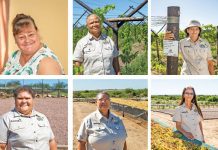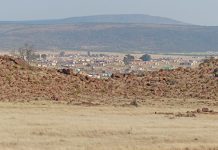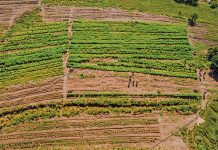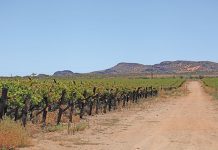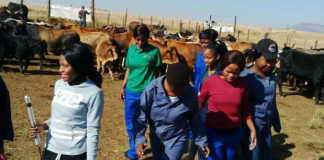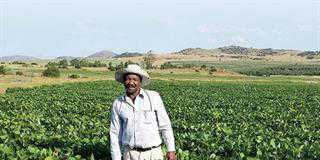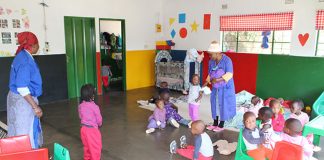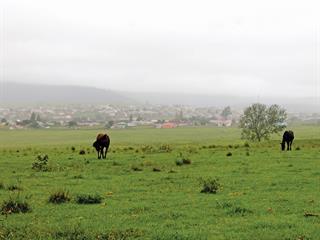
Zweliphi Sithole’s first two years as a full-time small- scale farmer have been a baptism by fire. In 2014, when he gave up his career of more than 20 years in government agricultural extension to pursue his lifelong dream of farming, the drought was already gaining momentum. He frowns as he discusses its affect on his KwaZulu-Natal business.
Minutes later, during his conversation with Farmer’s Weekly, the frown turns into a smile as rain begins falling on his six parched hectares of mixed-farming land. Sadly, it is nowhere near enough; much more rain is needed to refill the farm’s small irrigation dam, in which only a puddle of water remains. Zweliphi is pinning his hopes on predictions the drought may break soon.

He says the drought illustrates why it is important to spread financial risk with diversification.
“Now I don’t have enough water to irrigate my vegetable crops, and there’s not enough soil moisture to produce a good harvest of dryland maize. But at least I’ll still receive an income from my eggs, broilers and indigenous chickens. And, if in a good year of rain, my poultry get a disease, I’ll still receive an income from the crops,” he explains.
Strong ties to the land
Zweliphi has had a long association with the 1 500ha Ebuta Farm, situated in southern KZN, on which he farms a small portion. His late father, Maduda, was born on the farm in 1922 and worked there for most of his life. Zweliphi was also born on the farm and during his high school holidays worked for the owner, Mr DE Button, to earn extra income for his family.
Button sold Ebuta Farm to the government in 1992, and in 1996 the Sitholes and a number of other labour tenant families successfully claimed the farm through the then-new land reform process. Between Button selling the farm in 1992 and the claimants gaining ownership of the property, Zweliphi, his wife, Sizeka, and two children, Vuyokazi and Zwelethu, began leasing the farm homestead and the surrounding 6ha, on which to farm part-time. The lease became void once the claimants gained the title deed to Ebuta Farm in 1996.
Dedicated to his business
“Between 1992 and 2014 I was often travelling because of my agricultural extension work, so I couldn’t give my full attention to developing my small-scale farming business,” Zweliphi recalls. “In 1997, I was able to take six months’ unpaid leave to study poultry management at the KZN Poultry Institute. I knew that I wanted to farm poultry, but I just didn’t know when this would be.”
Since taking the plunge and resigning from his position at the KZN Department of Agriculture and Rural Development, Zweliphi has thrown himself into developing the foundations of a sustainable farming business. His diploma in agricultural production, his many years of experience as an agricultural extension officer, his poultry management qualification, the fertile land that he now owns and his retirement savings have all helped to develop the business.
Despite his knowledge and experience, however, Zweliphi is not ashamed to admit when he does not know something, and is quick to seek help, whether from published information, other farmers or agricultural experts. For example, he sends soil samples to the Cedara Agricultural Research Centre to have them analysed for fertiliser requirements.
He is just as keen to study potential markets.
“Ebuta Farm is right on the edge of uMzimkhulu, and I’m always doing market research to find out what farm products are in demand, and what their prices are. I then produce as many of these as I can. I also try to sell them at prices that customers living in uMzimkhulu can afford.”
Crop production
Zweliphi farms cabbages, spinach, pumpkins, eggs, broiler chickens and indigenous chickens, which he sells live for use in traditional ceremonies in the uMzimkhulu area.When there is sufficient rain, he grows yellow maize that he uses to feed his household’s indigenous chickens, geese and ducks. He is also in the process of planting his first commercial tomato and sugar bean crops.
“I grow 2ha of Green Coronet cabbages and Green Star cabbages, 2ha of Fordhook Giant spinach, and about 0,5ha of Queensland Blue pumpkins at the same time. However, I rotate these crops after almost every harvest to try to break pest and disease cycles. If the tomatoes and beans are successful, they’ll be brought into the crop rotation.”
When his irrigation dam has sufficient water, and if rain has been sparse, he will use garden sprinklers to apply supplementary water to his vegetable crops.
Cabbages
Zweliphi sources the cabbage seedlings from Sutherland Seedlings in nearby Ixopo, and produces about three consecutive crops of these frost-resistant varieties every year.
Seven days before hand-planting the seedlings at 35 000 plants/ha, he sprays the soil with glyphosate to kill any weeds or volunteer crops. Zweliphi is a believer in no-till practices and tries to disturb his soil as little as possible.
The seedlings are planted at an inter-row spacing of 45cm and at an intra-row spacing of 30cm.
“I plant my cabbages more densely than many other farmers because my land is limited, and I want to produce as many cabbages as possible,” he says. “They might be slightly smaller than normal, but I adjust my selling price accordingly. My customers are local hawkers and residents who come either to my farm stall or to the farm to buy.”
Spinach
Zweliphi also buys his frost-resistant spinach seedlings from Sutherland Seedlings. These are planted in September at 70 000 plants/ha, at an inter-row spacing of 40cm and an intra-row spacing of 20cm. It takes 60 days to 70 days from planting to first harvest. From then on, regrowth is harvested every two weeks, until being killed off with glyphosate in late August or early September.
The spinach is delivered to some shops and hawkers in uMzimkuhulu, while other hawkers and local residents buy directly from Zweliphi or his farmstall.
Pumpkins
While he aims to plant his pumpkins in September every year, drought conditions in late 2015 forced him to plant in December. He says that despite the late planting, the pumpkins were growing surprisingly well, probably due to the intermittent rainfall since January this year.
“I buy tins of Starke Ayres’s pumpkin seeds from the farmers’ co-op in Ixopo. I make slightly ridged rings set 40cm apart in the row and 150cm apart between rows. Three seeds are planted apart from each other in each ring. The seed spacing in each ring, and the spacing between the rings, allows the plants enough space to spread out across the soil surface. I usually get about five pumpkins from each seed.”
From planting it takes 90 to 100 days until he can begin harvesting. At present he sells the crop to local hawkers only, but plans to start negotiations with local retailers soon.
Layer hens and broilers
Zweliphi runs 200 Amberlink commercial layer hens at any one time in a small battery system. He buys his replacement hens at point-of-lay, when they are 18 to 20 weeks old, from a rearing facility in the Umbumbulu area. These birds have already been vaccinated against Newcastle Disease (ND) and Infectious Bursal Disease (IBD). He then continues to vaccinate them, via their drinking water, every four weeks, with ND and IBD vaccines.
He keeps his layers in production for about 12 months from point-of- lay, and sells them live as cull birds.At peak production, when they are 25 to 55 weeks old, layers collectively produce about 180 eggs/ day. The birds are fed with De Heus layer mash, collectively consuming about 150kg a week.
The eggs are packed as mixed sizes into boxes of 12 or trays of 30. Sold to local shops, hawkers, and through his farmstall, Zweliphi currently charges R14/ dozen or R32/tray.
He also produces 100 broilers every five to six weeks. He buys the day-old chicks from a supplier in Umlaas Road, which vaccinates them against ND and IBD.
“I vaccinate them again when they are 14 days old. I also put a stress pack of vitamins and minerals into the water to help them recover from the trip and adjust to their new environment.”
From day-old until 21 days, Zweliphi feeds his broilers with De Heus broiler starter mash or crumbles. From 21 days until they reach a saleable live-weight of 1,8kg to 2kg, they are fed De Heus broiler finisher pellets.
They are sold live from the farm for about of R50/bird. Zweliphi says that to keep up with demand he wants to build new broiler houses to increase production as soon as he is able to.
“It’s challenging to manage so many different enterprises, especially since I only have one permanently employed farm worker, and I do a lot of the farm work and all the marketing myself. I only hire casual labour from the local community for some of the larger jobs, such as planting and harvesting crops.
“The different enterprises greatly reduce my risk of not having any form of income from the farm – and keep my farming interesting!”
Phone Zweliphi Sithole on 073 218 0488 or email [email protected] or [email protected].



